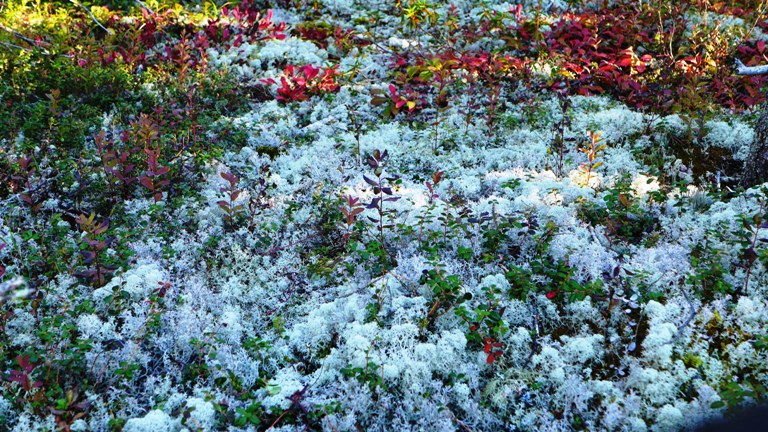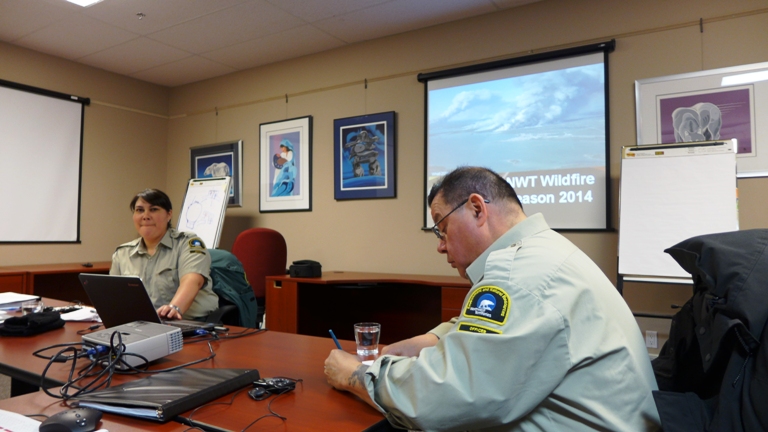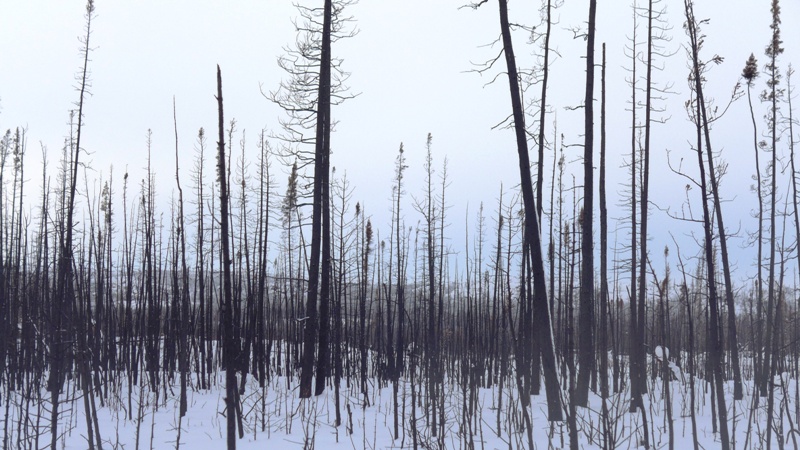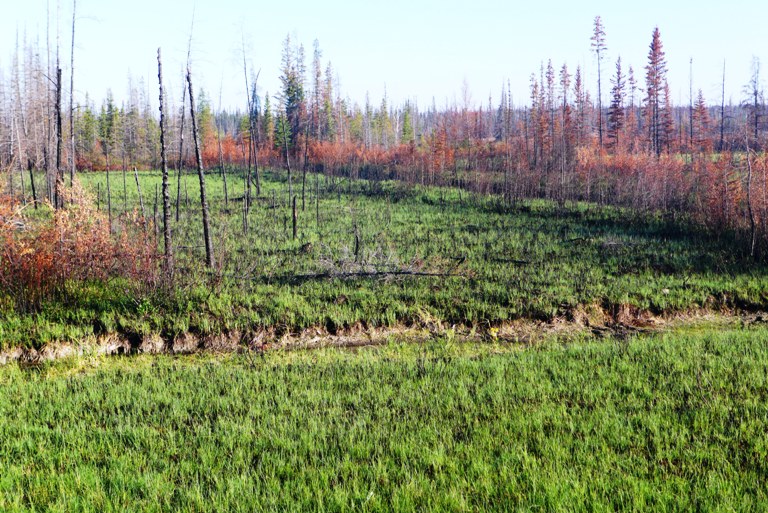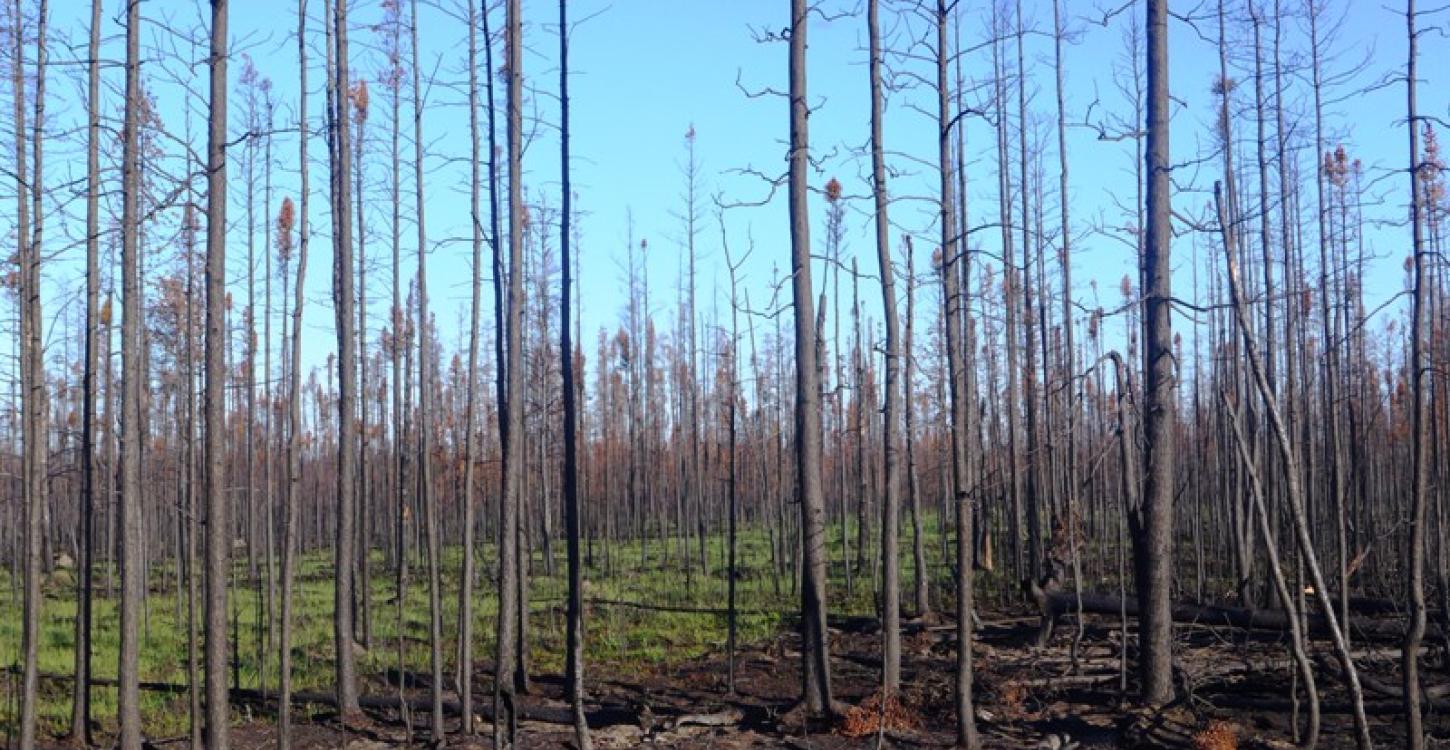
Forest Fire Season 2014 Update Presentation to the WRRB
March 20, 2015
Janice Ziemann, Forest Officer, and Roger Fraser, Manager, Forests, both from the North Slave Regional Office, Environment and Natural Resources (ENR), met with Board members at their meeting in January to update them on last year’s forest fire season and wildland fire management.
The 2014 NWT Wildfire fire season was one of the worst in decades. Between May and September, forest fires covered about 3.4 million hectares of boreal forest. From a total of 385 fires in the NWT, 143 fires burned in the North Slave region alone for a total of about 2.6 million hectares. Within Wek’èezhìı, all four Tłı̨chǫ communities were impacted by the fires, with areas near communities burnt, and smoke a constant concern. Hot, dry and windy weather, along with dry lightning early in the season, provided ideal conditions for the kind of intense wildfire the NWT experienced last summer. The last two winters (2012-2013 and 2013-2014) were the driest winters on record in the NWT; with a fast spring snow melt before the moisture could go into the ground and little rain, drought conditions resulted. Fire sometimes burned along the forest canopy, and there was extensive burning of normally “wet” areas. Roger described how fire burned right to the water’s edge and seeing lichen on rocks catch fire, something he had never seen before.
Their presentation explained that fire is part of the boreal forest ecosystem and a natural phenomenon in the NWT’s forests. Forest fire brings new life to the forest by returning valuable nutrients to the ground, warming the soil, and creating openings in the forest canopy letting more sunlight, heat and moisture fall on the forest floor so new plants can grow, creating meadow habitat.
While it is neither desirable nor possible to suppress all forest fires in a given landscape, it is important to fight some of them. Janice described the tools the Forest Management department uses to decide which fires to fight. Fire management involves efforts directed to protect life and other values that include property, primary forest and wildlife harvesting areas, endangered species areas, and culturally important areas.
If the climate changes as predicted and temperatures continue to rise, wildfires may become more frequent and severe in future due to drier forests and a longer burning season. It will be important to study the impacts of forest fire on wildlife and wildlife habitats through traditional and scientific knowledge research. For example, impacts of fire on caribou can include destruction of lichen, an important winter food that can take decades to recover, and changes in movement patterns as caribou look for better areas to feed. Some of the areas investigated in the Boreal Caribou (Tǫdzı) Habitat and Habitat Use project,for example, had to do with caribou habitat disturbed by fire, and began to look at questions such as: How do natural disturbances like forest fires affect the caribou’s movements and use of their habitat? How much longer after a fire do tǫdzı return to burn areas? More information is needed to understand how their numbers, distribution and behaviours might be affected by future disturbance, including fires. Future research on burn areas could include answering –how they are used by the caribou and how long it takes for them to regenerate back into places where caribou can forage. Currently, the WRRB has a traditional knowledge researcher collecting additional information on tǫdzı from elders in Whatì, including response to fire and use of winter habitats and islands.
Fact Box
- Forests are in three layers: from top to bottom, they are canopy, shrub layer, and forest floor
- Lightning strikes during “dry” thunderstorms are thought to have triggered most of the NWT fires in 2014. This occurs when the air below is so dry that any rain falling from the cloud evaporates before reaching the surface.
- Recolonization after fire occurs almost immediately. Fireweed seeds can remain in the soil for many years, ready to germinate when a new fire or other disturbance opens up the ground to light, one of the first plants to grow back after a fire. Shrubs, grasses, herbs, willows and birch often become established after a burn.
- Jack Pines and Black Spruce are adapted to the periodic passage of fire. Jack Pine cones are “locked” by sap. The heat from fire opens them so that their seeds can be released. Black spruce cones release seeds most readily when heated. This common tree in the northern boreal forest produces seeds much sooner than most other species and can spread rapidly after a forest fire.
- Herbivores (plant eaters) are the first to benefit from new growth after a burn. Unless an area has been severely burned, grasses and sedges begin to regrow quickly after forest fires. Bison have been observed returning into burn areas to forage on the fresh green growth after fire within two or three weeks. Forest fires can be a positive influence by creating bison habitat and encouraging forage.
- In time, predators such as wolves, foxes, lynx, and raptors move in.
